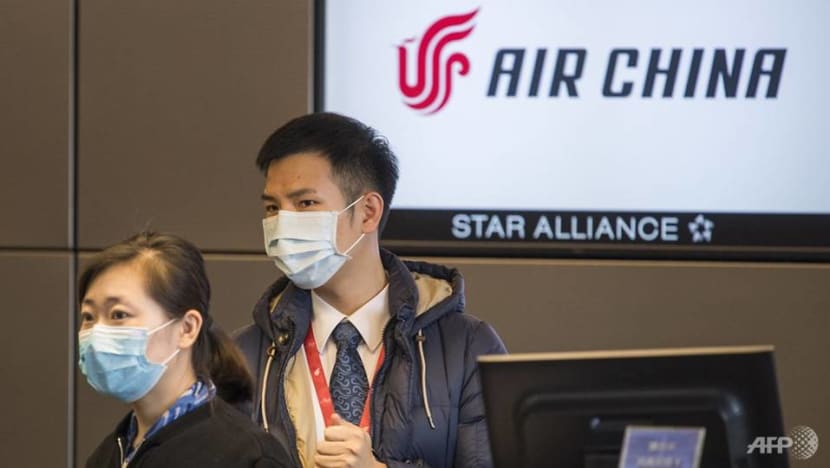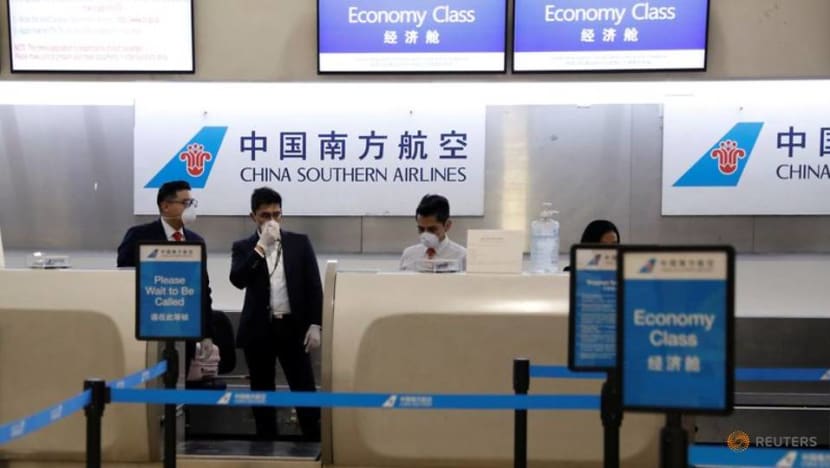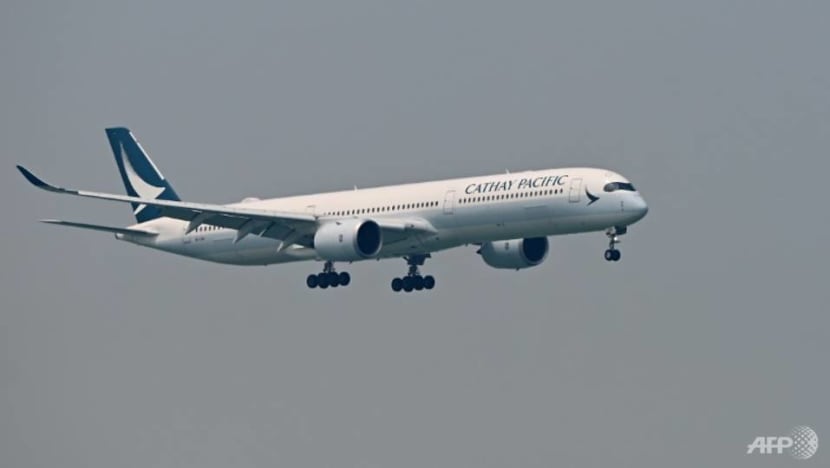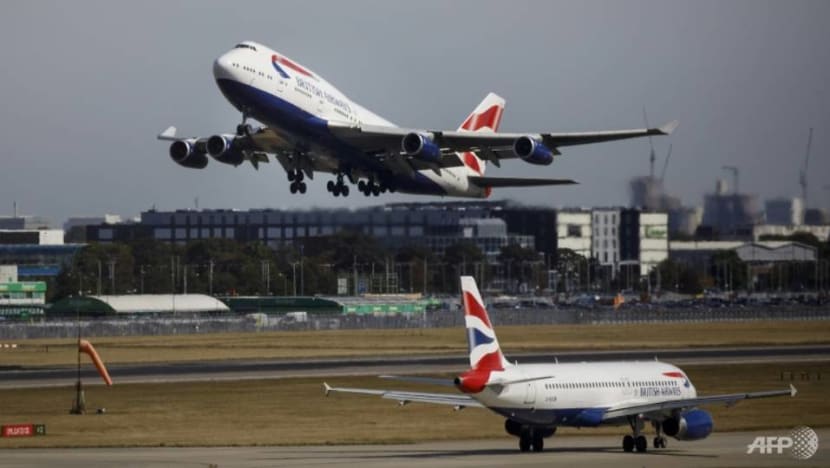commentary Commentary
Commentary: Novel coronavirus turns 2020 into a bleak year for Asian airlines
With Asia’s largest market ground to a halt, the first half of the year can be written-off for many of the region’s carriers, says Brendan Sobie.

Air China staff wear face masks to protect against the spread of the coronavirus as they check in passengers on an Air China flight to Beijing, at Los Angeles International Airport, California, on Feb 2, 2020. (Photo: AFP/Mark Ralston)
SINGAPORE: The emergence of the coronavirus virus could not have come at a worse time for Asian airlines.
The Asian airline sector was already struggling with weaker overall financials compared to its European or North American counterparts due to intense competition, overcapacity and the instability in Hong Kong.
Despite this, Asian airlines were still in the black overall last year and the outlook for 2020, while not exactly bright, was for continued modest profits. But in just a couple of weeks, the outlook has become downright dismal, with significant losses now likely for at least the first half of the year.
REELING FROM A CHINA SHUTDOWN
Passenger traffic to and from mainland China, which had been a bright spot in the initial 2020 outlook for both growth and profitability, has virtually ceased.
READ: Commentary: Tourism in Asia takes a beating after Wuhan coronavirus outbreak
China’s international market is massive and a critical component for most major Asian airline groups. A majority of foreign airlines have suspended services to mainland China entirely and those airlines that have for now maintained some services are operating a skeleton of their normal operations at 20 per cent or less.
Flights in and out of China exceeded 160 million passengers in 2019. This includes Hong Kong and Macau - - a segment which was down slightly last year due to the protests in Hong Kong while the rest of the international market recorded double-digit growth.
Outbound travel dominates China’s international aviation market and has fuelled rapid growth in recent years as more mainland Chinese residents have started holidaying overseas.
China is now the largest source market for most Asian countries’ tourism industries and the sudden suspension of virtually all outbound China travel will have a crippling impact on economies as well as airlines.
For example, Thailand attracted 11 million Chinese visitors in 2019, amounting to 28 per cent of Thailand’s total number of visitors, and Japan attracted nearly 10 million Chinese visitors, which was 30 per cent of its total.
CHINA’S DOMESTIC MARKET TAKES A BIG HIT
Foreign airlines account for slightly less than half of China’s international market and have been expanding much slower in recent years than mainland Chinese carriers.

Chinese airlines grew traffic in and out of the mainland by around 15 per cent in 2019 to approximately 86 million passengers.
China’s domestic market, which consisted of about 586 million passengers in 2019, is also significantly impacted by the coronavirus.
However, a much larger portion of domestic flights continue to operate compared to the international market, with the exception of Wuhan, which has been shut off from the rest of China. The domestic market will also recover more quickly once the virus subsides.
READ: Commentary: Novel coronavirus reveals old vulnerabilities in the global economy
Nonetheless, the 2020 outlook for all Chinese airlines is bleak. China’s massive domestic market is unlikely to grow this year for the first time since SARS. The extent of the damage will hinge on how long it takes for the virus to become contained.
Even assuming a recovery in the second half of 2020, which is feasible if we extrapolate from the recovery rate following SARS and other shocks, China’s domestic market could shrink to below 500 million passengers, putting it back to 2017 levels.
The international market could shrink below 120 million, which is equivalent to 2016 levels.
AIRASIA AND CATHAY BEAR THE BRUNT
While the domestic reduction is huge even in the global context - a reduction of 100 million passengers would represent 2 per cent of the global total - the international reduction could have a bigger impact on revenue and would impact a much larger number of airlines.
To put this into context, the 750 million passengers that travelled into, out of and within China in 2019 accounts for 16 per cent of the global total number of passengers who flew during the year – 4.6 billion according to IATA.
Over 120 foreign airlines serve China although a handful of airline groups, including all their subsidiaries, account for over one-third of total foreign airline traffic.
Taking into account their subsidiaries, Cathay Pacific and AirAsia have the biggest exposure to China, each with roughly a 10 per cent share of total foreign airline traffic to and from China. The Asiana, Korean Air and Singapore Airlines groups – the latter including SilkAir and Scoot - also each have at least a 5 per cent share.

There is never a good time for a crisis but for AirAsia and Cathay the timing of the coronavirus is awful. AirAsia is grappling with a decline in profitability which resulted in losses in 2019 at virtually all nine of its airlines and a corruption scandal which has resulted in its two top executives temporarily stepping down.
Cathay had an already dismal 2019 as the inbound demand to Hong Kong plummeted in the second half due to the protests. Its mainland China traffic was the hardest hit as Chinese visitor numbers to Hong Kong plummeted and Cathay’s brand in China was tarnished by political backlash that led to the resignation of its highly respected CEO Rupert Hogg in August.
READ: Cathay Pacific asks 27,000 employees to take unpaid leave as coronavirus outbreak hit demand
Cathay was able to partially offset the decline in inbound demand with more transit traffic but this type of traffic is lower yielding, impacting profitability.
Now the transit segment and outbound traffic, which held up following the protests, is impacted by the coronavirus as well as inbound traffic. Cathay has slashed its mainland China capacity by 90 per cent through at least March and also has cut global capacity by 30 per cent.
All Asian airlines are impacted by the coronavirus but excluding the mainland Chinese carriers Cathay is the most impacted given its exposure to the mainland market.
During normal time, routes to and from mainland China account for about 20 per cent of Cathay's passengers. Several others major Asian airline groups including AirAsia have between 5 to 10 per cent exposure rate to mainland China.
WORSE THAN SARS FOR ASIAN AIRLINES
Cathay and other Asian airline groups have no choice but to drastically cut back and wait for the storm to subside. Historically markets recover quickly after these types of situations. However for Cathay and mainland Chinese airlines there is now no escaping a dismal first half of 2020.

Other Asian airline groups may still be able to scrape by with small profits or relatively small losses but the outlook is relatively bleak.
IATA was projecting a 2.2 per cent net margin for Asia Pacific airlines overall in 2020. This represented a slight improvement compared to 2019 but already seemed overly optimistic given market conditions prior to onset of the coronavirus.
READ: Commentary: Looks like containment of novel coronavirus not as effective as we had hoped
The average margin for Asian airlines has been razor thin and well below the average return on capital in recent years despite record global airline profits, driven by relatively high margins for North America and Europe since there was greater consolidation of airlines in these two regions driving up profitability there.
While the coronavirus will impact the major airlines in North America and Europe, the gap in profits between these regions and Asia will now widen further in 2020.
The first half of the year can be written off for several major Asian airline groups. We can only hope the recovery will be as quick as it has been historically, making for a better second half but still a bleak full year.
Over the longer-term, rest assured the outlook remains bright.
The impact on traffic, revenue and profits will almost certainly be larger than SARS as Asia’s aviation industry, particularly China, is much larger than it was in 2003.
However, the industry will rebound once this crisis is over – just like it has before. External events that no one has any control over has always been part of the airline industry’s DNA, resulting in major short-term setbacks.
Time and time again the industry emerges from the ashes stronger than ever.
BOOKMARK THIS: Our comprehensive coverage on the Wuhan coronavirus and its developments
Brendan Sobie is the founder of Singapore-based independent aviation consulting and analysis firm Sobie Aviation. He was previously chief analyst for CAPA - Centre for Aviation.












